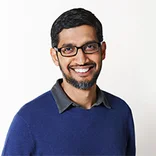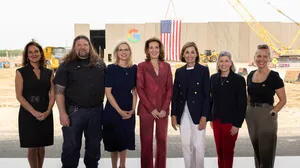Building for our AI future
Ed note: Today, Google and Alphabet CEO Sundar Pichai shared a number of structural changes to improve velocity and execution across the company. His note to employees is below.
Hi Googlers,
We’re coming off an amazing Cloud Next — congrats again to all involved. It was nice to see the recognition of our leading AI tools and infrastructure, and all the ways our customers are using them. Excited to show more progress during our earnings call next Thursday. Today, I want to share some changes we’re making across the company to simplify decisions and help us work better and faster.
There’s context below for the changes in 4 parts: 1. Models and Research; 2. Responsible AI; 3. Platforms and Devices; and 4. Mission First. It's a long note, but I want you to see the full rationale.
These changes continue the work we've done over the past year to simplify our structure and improve velocity and execution — such as bringing together the Brain team in Google Research with teams in DeepMind, which helped accelerate our Gemini models; unifying our ML infrastructure and ML developer teams to enable faster decisions, smarter compute allocation, and a better customer experience; and bringing our Search teams under one leader.
- Sundar
State-of-the-art foundation models and research
Last year we created Google DeepMind, bringing together the Google Brain team, DeepMind, and other researchers specifically focused on creating increasingly capable and general AI systems.
The progress in just one year has been incredible: Gemini models are seen as leaders and keep getting better. And our successive breakthroughs have put us on a path to deliver the world’s most advanced, safe, and responsible AI.
Now, to accelerate this progress, we’re going to consolidate the teams that focus on building models across Research and Google DeepMind. All of this work will now sit in Google DeepMind and scale our capacity to deliver capable AI for our users, partners and customers. This will simplify development by concentrating compute-intensive model building in one place and establishing single access points for PAs looking to take these models and build generative AI applications.
This change also gives Google Research a clear and distinct mandate to continue investing in foundational and applied computer science research in three key areas that tie directly to Google’s mission: computing systems (including quantum), foundational ML and algorithms, and applied science and society. Fundamental computer science research is in our DNA and we have some of the world's best computer scientists. We simply would not be the company we are today without the researchers who developed the foundations on which all Google’s products are built and are now inventing the foundations for our future.
Excited to see what these teams accomplish in their new formation. James in his role across Research and Tech & Society and Labs will continue to oversee Google Research with Yossi as the dedicated leader reporting to him. James and Demis will keep working as closely as they always have, and Google DeepMind and Google Research will continue their collaborations.
Responsibility and safety
We are a longstanding leader in building and deploying responsible AI. Last year, along with other companies, we committed to a set of measures to develop AI safely and responsibly.
We need to be the best in class at deploying accurate, trustworthy, and transparent AI products for users and customers. To help do this, we're making changes to the way our Responsible AI teams work at crucial points in the development cycle.
- We’re moving Responsible AI teams in Research to Google DeepMind, to be closer to where the models are built and scaled.
- We've recently moved other responsibility teams into our central Trust and Safety team, where we are investing more in AI testing and evals.
- These shifts create clearer responsibility and accountability at every level as we build and deploy, and strengthen the feedback loop between models, products, and users.
Beyond these changes, our teams have also been working hard to improve our processes and are making good progress: We’re standardizing launch requirements for AI-powered features and increasing investments in “red team” testing for vulnerabilities and broader evaluations to help ensure responses are accurate and responsive to our users’ prompts. This is vital, ongoing work.
Computing platforms and devices
AI gives us an incredible opportunity to reimagine computing platforms for the next decade — transforming Android, Chrome, Search, Photos and so many other products to be more helpful for people everywhere.
To truly drive computing forward, we need to do it at the intersection of hardware, software and AI. So we are formalizing the collaboration between DSPA and P&E and bringing the teams together in a new PA called Platforms & Devices. And the Google Research teams focused on computational photography and on-device intelligence will also be moving over to join the new org to bring deep AI expertise across platforms and devices.
Having a unified team across Platforms & Devices will help us deliver higher quality products and experiences for our users and partners. It will help us turbocharge the Android and Chrome ecosystems, and bring the best innovations to partners faster — as we did with Circle to Search with Samsung. And internally, it will also speed up decision-making.
Rick will oversee the entire PA and Sameer will step up to lead across our Android ecosystem. Hiroshi, who has done so much to grow Android, Chrome, ChromeOS, G1 and Photos, will advise on the transition even as he starts work on some new projects across Alphabet. This includes piloting a new role as executive sponsor of Japan. Hiroshi and I have been discussing these changes for many months, and I’m excited to see him lead across a new set of challenges.
Our P&E and DSPA teams have made such great progress in recent years: Google One just passed 100M subscribers, Chrome is used by billions of people, and Android — now at 3 billion active devices and counting — is only getting stronger. It enables a vibrant ecosystem of manufacturers, carriers, silicon makers like Qualcomm, and hundreds of thousands of developers who use the platform to compete in the global market. On top of that, our Pixel family of devices has been growing well, and helps to spur innovation — and accelerate the adoption of the latest Android and AI features — across the ecosystem. It’s exciting to see these teams joining forces and strengthening their collaboration to benefit users and partners.
Mission first
One final note: All of the changes referenced above will help us work with greater focus and clarity towards our mission. However, we also need to be more focused in how we work, collaborate, discuss and even disagree. We have a culture of vibrant, open discussion that enables us to create amazing products and turn great ideas into action. That's important to preserve. But ultimately we are a workplace and our policies and expectations are clear: this is a business, and not a place to act in a way that disrupts coworkers or makes them feel unsafe, to attempt to use the company as a personal platform, or to fight over disruptive issues or debate politics. This is too important a moment as a company for us to be distracted.
We have a duty to be an objective and trusted provider of information that serves all of our users globally. When we come to work, our goal is to organize the world’s information and make it universally accessible and useful. That supersedes everything else and I expect us to act with a focus that reflects that.
Thank you.




